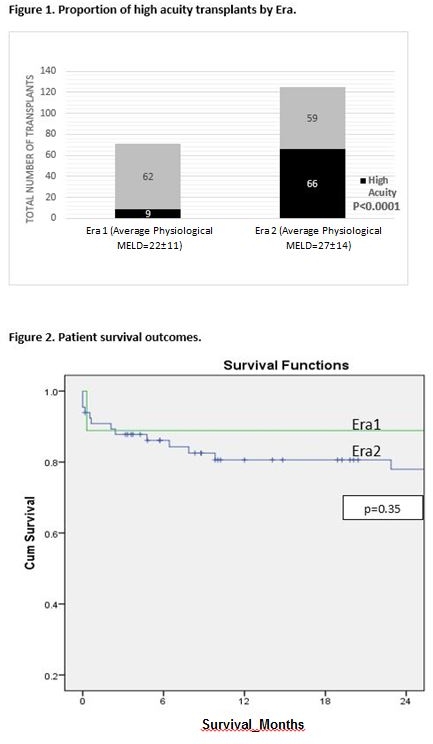Specialized Transplant Critical Care Model Improves Access to Transplantation and Short-Term Survival Outcomes after Liver Transplantation in the Highest Acuity Patients
1Department of Surgery, Division of Transplant Surgery, Medical College of Wisconsin, Milwaukee, WI
2Department of Anesthesia, Medical College of Wisconsin, Milwaukee, WI
3Department of Medicine, Division of Nephrology, Medical College of Wisconsin, Milwaukee, WI
4Department of Medicine, Division of Gastroenterology, Medical College of Wisconsin, Milwaukee, WI.
Meeting: 2018 American Transplant Congress
Abstract number: C222
Keywords: Liver transplantation, Morbidity, Mortality, Outcome
Session Information
Session Name: Poster Session C: Liver: Recipient Selection
Session Type: Poster Session
Date: Monday, June 4, 2018
Session Time: 6:00pm-7:00pm
 Presentation Time: 6:00pm-7:00pm
Presentation Time: 6:00pm-7:00pm
Location: Hall 4EF
Objective: Liver transplantation (LT) is a lifesaving treatment for end stage liver disease (ESLD). High acuity ESLD patients are disadvantaged as they are frequently denied by transplant centers due to the severity of illness. We analyzed outcomes after LT in high acuity patients using a specialized transplant critical care model (TCCM).
Methods: We analyzed data from our prospective database: 122 adults were listed with lab MELD≥35 or Status 1 from Jan. 2009 to Dec. 2016. Era 1 (prior to TCCM) was compared to Era 2 (TCCM established Oct. 1, 2012). Median follow up: 20 months.
Results: TCCM (Era 2) led to a significant increase in patients' access to LT and LT rate (Table & Fig 1). Frequency and need to seek LT at another center dropped 4 fold in Era 2. Most patients in Era 2 were in ICU prior to LT (83% vs. 25%, p<0.01) and on renal replacement therapy (67% vs. 13%, p<0.01). Despite higher acuity of illness in Era2, 1–year patient survival (Fig 2) was comparable (89% Era1, 80% Era 2, p=0.35).
Conclusion: Implementation of specialized transplant critical care model expanded LT access to high acuity patients, diminished seeking higher level of care elsewhere, and achieved excellent short-term post-transplant survival outcomes in critically ill patients.
| Era1 | Era2 | p-value | |
| Average additions/year-All | 39±6 | 73±9 | 0.001 |
| Number added-High Acuity | 23 | 99 | 0.0001 |
| Delisted-High Acuity | |||
| -Transplanted | 38% | 67% | 0.01 |
| -Died on list | 5% | 16% | NS |
| -Too sick/refered | 57% | 15% | 0.001 |
| -Improved | 0 | 2% | NS |
Table 1. Waitlist outcomes.
CITATION INFORMATION: Selim M., Zimmerman M., Kim J., Pearson T., Eriksen C., Wong M., Boettcher B., Regner K., Saeian K., Woehlk H., Hong J. Specialized Transplant Critical Care Model Improves Access to Transplantation and Short-Term Survival Outcomes after Liver Transplantation in the Highest Acuity Patients Am J Transplant. 2017;17 (suppl 3).
To cite this abstract in AMA style:
Selim M, Zimmerman M, Kim J, Pearson T, Eriksen C, Wong M, Boettcher B, Regner K, Saeian K, Woehlk H, Hong J. Specialized Transplant Critical Care Model Improves Access to Transplantation and Short-Term Survival Outcomes after Liver Transplantation in the Highest Acuity Patients [abstract]. https://atcmeetingabstracts.com/abstract/specialized-transplant-critical-care-model-improves-access-to-transplantation-and-short-term-survival-outcomes-after-liver-transplantation-in-the-highest-acuity-patients/. Accessed December 28, 2025.« Back to 2018 American Transplant Congress

